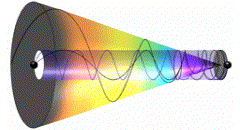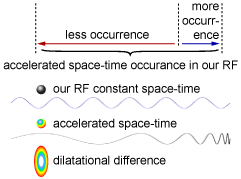
Universal principle of gravitation and acceleration
It is necessary to describe difference between gravitation and acceleration.
Gravitation is a factor of space-time stretching measured for one light second space-time fraction
![]()
In other words, gravitation is the amount of space for which 1 light second space-time stretches in corresponding dilatational fraction of time. So gravitation is in fact light speed dilatation (one light space fraction is because our units for time and space are second and meter). The definition for space which equals to a product of speed and time implies that gravitation is a universal variable for space.
Since speed of light for any space-time frame measures the same, means, that relatively to our RF different space-times have different speed of light. It manifests as different wave lengths (wave times) as a consequence of different occurrence of space in time (fig.01).
 |
 |
 fig. 01 fig. 01 |
In spite of its uniqueness among forces, because it always attracts and never repel, classical model incorrectly interprets gravitation as a force. Moreover, it is considered as a fundamental force of nature.
Acceleration is a space-time stretching measured for acceleration space-time fraction in corresponding acceleration dilatation "da".
![]()
To calculate acceleration “a”, the following equation is used;
![]()
where "d1" and "d2" represent dilation values for different space-time markers. For corresponding gravitational values "g1" and "g2" are used.
Follows that the acceleration describes the advance of gravitation.
Dilatational amount “D” equals to a sum of speed of light and gravitation divided by speed of light, i.e. division of dilated (“cd”) and measured speed of light. It describes the change of space-time calculated in meters and seconds rather then in space-time universal variables.
![]()
![]()
![]()
![]()
![]()
Relative change of light speed, measured from our RF, is equivalent to a sum of speed of light and measured RF gravitation. It also equals to a product of speed of light and dilatational amount.
![]()
![]()
![]()
Since dilated amount of relative speed of light equals to a sum of measured light speed and gravitation, true light speed on Earth surface, in corresponding accelerational-dilatational fraction of space-time, is in fact enlarged for the amount of its acceleration (9,807m for Earth's surface). Having in mind that our space-time is stretched for the same amount in corresponding accelerational dilatational fraction, measured speed of light would be
![]()
which amounts unchanged 299 792 458 m/s.
Following the logic of light speed description, we express the time fraction "dvo" in which light moves over orbital velocity “vo” space fraction;
![]()
Given amount multiplied with orbital velocity equals to corresponding orbital gravitation
![]()
![]()
Analogously to gravitational dilatation, gravitation for celestial body light second space fraction equals to a square root of its margin space markers acceleration product.
![]()
where “a1” represents acceleration on surface, and “a2” stands for acceleration at one light second distance space fraction.